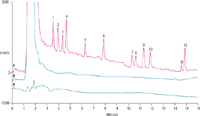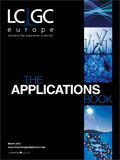Faster, More Sensitive Determination of Carbamates in Drinking Water
Thermo Scientific Application Note
U.S. EPA Method 531.2 describes the determination of widely used carbamate pesticides in raw surface water using HPLC with fluorescence detection following postcolumn derivatization, which enhances method sensitivity and selectivity as compared to UV absorbance detection. Per European Union (EU) regulation 98/83/EC for pesticides in drinking water, the maximum admissible concentration of each individual pesticide component is 0.1 µg/L, and the total concentration is not to exceed 0.5 µg/L. Detection of these regulated compounds at such low concentrations poses a challenge for many water testing laboratories using EPA Method 531.2.
This work describes a faster and more sensitive method for the determination of the carbamates specified in EPA Method 531.2. Separation is performed on a Thermo Scientific Acclaim Carbamate column with detection using a Thermo Scientific Dionex FLD-3400RS Fluorescence Detector. Following separation, the carbamates are derivatized with o-phthalaldehyde (OPA) and detected by fluorescence. Baseline separation of these carbamate compounds is achieved within 20 min with resolutions (Rs) ≥ 1.5.
Equipment
The experimental setup and sample preparation procedures are described in Application Update 177, Thermo Fisher Scientific, Inc. (formerly Dionex Corp.).
RESULTS AND DISCUSSION
Chromatography
Figure 1 trace (c) illustrates good separation of the carbamates listed in EPA Method 531.2 using the Acclaim Carbamate column, designed for the baseline separation of these carbamates. Resolution (Rs) for all peaks is ≥1.5, exceeding the EPA Method required values (≥1.0). The mixture of carbamates was added to a tap water sample at a concentration of 0.4 µg/L each, demonstrating method sensitivity. Traces (a) and (b) show deionized water and the tap water sample, respectively. No detectable carbamates were found in the tap water.

Figure 1
Minimum Detection Limits (MDLs)
Per EPA Method 531.2, nine replicate injections of reagent water fortified with 0.2 µg/L of carbamate standard mixture were used to determine the MDLs. They ranged from 0.004 to 0.010 µg/L, four to ten-fold lower than reported in the 531.2. The improved MDLs may be attributed to the improvements in fluorescence detector sensitivity and reversed-phase column technology since the original EPA work was completed. The EPA method uses a 4 µm, 3.9 × 150 mm column, while this method used a 3 µm, 3.0 × 150 mm column to yield more efficient peaks. These improved detection limits easily allow the analyst to reach the minimum reporting limits of the original method.
CONCLUSION
Described here is an optimized method for determining carbamates in drinking water on a Dionex HPLC system with a 3 µm Acclaim Carbamate column. Improvements in MDLs (≤0.01 µg/L) and quantification limit (0.05 µg/L) significantly exceed the values in EPA Method 531.2 and meet the requirements of EU 98/83/EC, making it ideally suited for determining carbamates in drinking water.
Scan to receive complete application note.
Thermo Fisher Scientific, Inc. (formerly Dionex Corp.)
1228 Titan Way, P.O. Box 3603, Sunnyvale, CA 94088, USA
tel. (408) 737-0700, fax (408) 730-9403
Website: www.thermoscientific.com/dionex

Analytical Challenges in Measuring Migration from Food Contact Materials
November 2nd 2015Food contact materials contain low molecular weight additives and processing aids which can migrate into foods leading to trace levels of contamination. Food safety is ensured through regulations, comprising compositional controls and migration limits, which present a significant analytical challenge to the food industry to ensure compliance and demonstrate due diligence. Of the various analytical approaches, LC-MS/MS has proved to be an essential tool in monitoring migration of target compounds into foods, and more sophisticated approaches such as LC-high resolution MS (Orbitrap) are being increasingly used for untargeted analysis to monitor non-intentionally added substances. This podcast will provide an overview to this area, illustrated with various applications showing current approaches being employed.

















